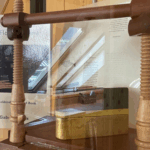The bone folder tool is hands-down the most important item in my bookbinding kit. I use it to crease and score paper, smooth glued endpapers, define hinges, form leather head caps and so much more. Over the years, I’ve learned bone folders are both important and personal. What is right for me might not be right for someone else.
In this post, I’ll give a quick history of these awesome tools and then chat about the different types and uses to help you choose the right bone folder tool for you.
What is a bone folder tool?
A bone folder is a simple tool usually (but not always) made of polished animal bone. It has one pointed end for scoring and one rounded end for smoothing. The long side of the tool is used to crease paper without leaving marks or damaging delicate paper.
While bone folders are usually associated with paper, they’re also used to delaminate and burnish materials like fabric and leather. Most bone folders are about 6 inches in length, but can be anywhere from 4 to 12 inches.
When did we start using bone folders?
Some the earliest known bone folders were found in China, but there is evidence to suggest these might have existed all over the world as early as the appearance of the modern codex (circa 200-450 BCE). Chinese bone folders were most likely used for origami and later to score and crease paper used in book making.
All early bone folders were hand carved. Many of these tools are still hand carved today by the bookbinders who use them.
5 must-have features for any bone folder tool
I dive into each of these features in my post, Top 5 Features to Look for in a Bone Folder.
- Non-stick (won’t catch or stick to paper)
- Easy to shape into round, pointed or tapered ends
- Strong and durable
- Smooth (no jagged edges, easy to glide on material)
- Will not damage paper
Choosing the right bone folder for you
The “right” folder is a personal preference, so there are a few things to consider.
- Vegan. If you want to avoid animal products entirely, be sure to select a folder made of wood, metal, plastic or polymers. Avoid bone, horn and ivory.
- Environmentally-friendly. If organic products are important, then bone, horn, wood and rock are great choices. Avoid polymers and plastics, which use petroleum and are toxic when burned.
- Ethically-sourced. If ethically sourced products are important, do some research on the procurement and manufacturing process of all organic folders (plant and animal). Rock is your best second choice. Polymers and plastics are a third and final choice if you’re okay with petroleum products.
- Uniqueness. As an artisan, you might be interested in very unique bone folders. In this case, look into hand-carved bone, wood and rock folders. Many of these can be custom engraved using a laser.
- Cost. For a less expensive option, focus on Teflon and ABS plastic bone folders. These are mass produced in many different shapes and sizes, so there is a folder for every need. If cost is not a factor, look for a hand carved folder (preferably by a bookbinder).
Bone folders aren’t always made of bone. I wrote about 5 Unexpected Materials used to make Bone Folder Substitutes if you want to read more.
My preferred bone folder
I get my bone folders from India, where our cow friends are revered. I know the company and they truly care about the folders and using every part of the animal properly. That’s why I confidently include them in my tool and book kits.
My folders are traditional: rounded at one end with a soft point on the other and two velvety, rounded edges that glide beautifully. The point is not too thick and not too thin (about 0.6-0.7mm). While the point is narrow, it’s smooth. Some bone folders have jagged points that will tear or mar paper. Always feel the tip of the folder before buying.

I hope you can find a bone folder that will work for your personal needs while giving you the ability to make gorgeous books!
More bookbinding goodness
✨ What tools do I need to get started bookbinding?
- Bookbinding Tools & Supplies Quick Start Guide – learn all about book making tools, which to buy first & where to go online
- Pick up my popular Complete Starter Bookbinding Tools Kit – all the bookbinding essentials in one spot
🌟 Looking for a simple way to start making books?
Try a Complete Book Materials Kit. Each one has everything you need (+ tutorials & videos) to make a beautiful book without all the fuss.
Thank you for taking me along on your book making journey!
Misty












